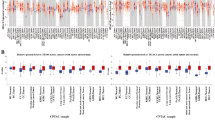Abstract
Purpose
DYX1C1 has three alternatively spliced transcripts. Therefore, we expect that alternative transcripts of DYX1C1 are used as a biomarker to detect specific cancer.
Methods
RT-PCR analysis is conducted in order to detect expression of the DYX1C1 gene and the PCR products were analyzed using the Image J program to compare the expression levels of each transcript.
Results
We found one of the transcripts was directly associated with an HERV-H LTR element that could be translated into protein sequence. Four new alternative transcripts were identified by RT-PCR analysis with various human tissue samples including 10 normal and adjacent tumor tissue sets. Semi-quantitative RT-PCR analysis showed the transcriptional activity of V3 and V2 was higher in tumor than in normal tissue samples, especially in the colorectal tissue samples.
Conclusion
Our results indicated that alternatively spliced transcript variants of the DYX1C1 gene could be used as cancer biomarkers to detect colorectal cancer.




Similar content being viewed by others
References
Badran A, Yoshida A, Ishikawa K, Goi T, Yamaguchi A, Ueda T et al (2004) Identification of a novel splice variant of the human anti-apoptopsis gene survivin. Biochem Biophys Res Commun 314:902–907. doi:10.1016/j.bbrc.2003.12.178
Brinkman BM (2004) Splice variants as cancer biomarkers. Clin Biochem 37:584–594. doi:10.1016/j.clinbiochem.2004.05.015
Chang BS, Ly J, Appignani B, Bodell A, Apse KA, Ravenscroft RS et al (2005) Reading impairment in the neuronal migration disorder of periventricular nodular heterotopia. Neurology 64:799–803
de Parseval N, Alkabbani H, Heidmann T (1999) The long terminal repeats of the HERV-H human endogenous retrovirus contain binding sites for transcriptional regulation by the Myb protein. J Gen Virol 80:841–845
Fisher SE, Francks C (2006) Genes, cognition and dyslexia: learning to read the genome. Trends Cogn Sci 10:250–257. doi:10.1016/j.tics.2006.04.003
Galaburda AM, Sherman GF, Rosen GD, Aboitiz F, Geschwind N (1985) Developmental dyslexia: four consecutive patients with cortical anomalies. Ann Neurol 18:222–233. doi:10.1002/ana.410180210
Ge K, DuHadaway J, Du W, Herlyn M, Rodeck U, Prendergast GC (1999) Mechanism for elimination of a tumor suppressor: aberrant splicing of a brain-specific exon causes loss of function of Bin1 in melanoma. Proc Natl Acad Sci USA 96:9689–9694. doi:10.1073/pnas.96.17.9689
Hirose Y, Takamatsu M, Harada F (1993) Presence of env genes in members of the RTVL-H family of human endogenous retrovirus-like elements. Virology 192:52–61. doi:10.1006/viro.1993.1007
Krieg A, Mahotka C, Krieg T, Grabsch H, Müller W, Takeno S et al (2002) Expression of different survivin variants in gastric carcinomas: first clues to a role of survivin–2B in tumour progression. Br J Cancer 86:737–743. doi:10.1038/sj.bjc.6600153
Li F (2005) Role of survivin and its splice variants in tumorigenesis. Br J Cancer 92:212–216
Mahotka C, Wenzel M, Springer E, Gabbert HE, Gerharz CD (1999) Survivin-deltaEx3 and survivin–2B: two novel splice variants of the apoptosis inhibitor survivin with different antiapoptotic properties. Cancer Res 59:6097–6102
McGrath LM, Smith SD, Pennington BF (2006) Breakthroughs in the search for dyslexia candidate genes. Trends Mol Med 12:333–341. doi:10.1016/j.molmed.2006.05.007
Meng H, Lu CD, Sun YL, Dai DJ, Lee SW, Tanigawa N (2004) Expression level of wild-type survivin in gastric cancer is an independent predictor of survival. World J Gastroenterol 10:3245–3250
Nelson DT, Goodchild NL, Mager DL (1996) Gain of Sp1 sites and loss of repressor sequences associated with a young, transcriptionally active subset of HERV-H endogenous long terminal repeats. Virology 220:213–218. doi:10.1006/viro.1996.0303
Pajares MJ, Ezponda T, Catena R, Calvo A, Pio R, Montuenga LM (2007) Alternative splicing: an emerging topic in molecular and clinical oncology. Lancet Oncol 8:349–357. doi:10.1016/S1470-2045(07)70104-3
Pennington BF, Smith SD (1983) Genetic influences on learning disabilities and speech and language disorders. Child Dev 54:369–387. doi:10.2307/1129698
Ryan B, O’Donovan N, Browne B, O’Shea C, Crown J, Hill AD et al (2005) Expression of survivin and its splice variants survivin-2B and survivin-DeltaEx3 in breast cancer. Br J Cancer 92:120–124. doi:10.1038/sj.bjc.6602314
Sin HS, Huh JW, Kim DS, Kim TH, Ha HS, Kim WY et al (2006) Endogenous retrovirus-related sequences provide an alternative transcript of MCJ genes in human tissues and cancer cells. Genes Genet Syst 1:333–339. doi:10.1266/ggs.81.333
Sin HS, Huh JW, Kim WY, Kim DS, Ahn K, Ha HS et al (2007) Long terminal repeats of human endogenous retrovirus H family provide alternative polyadenylation signals to NADSYN1 gene. Korean J Genet 29:395–401
Skotheim RI, Nees M (2007) Alternative splicing in cancer: noise, functional, or systematic? Int J Biochem Cell Biol 39:1432–1449. doi:10.1016/j.biocel.2007.02.016
Smith SD, Kelley PM, Brower AM (1998) Molecular approaches to the genetic analysis of specific reading disability. Hum Biol 70:239–256
Sokol DK, Golomb MR, Carvalho KS, Edwards-Brown M (2006) Reading impairment in the neuronal migration disorder of periventricular nodular heterotopia. Neurology 66:294 (author reply 294)
Taipale M, Kaminen N, Nopola-Hemmi J, Haltia T, Myllyluoma B, Lyytinen H et al (2003) A candidate gene for developmental dyslexia encodes a nuclear tetratricopeptide repeat domain protein dynamically regulated in brain. Proc Natl Acad Sci USA 100:11553–11558. doi:10.1073/pnas.1833911100
Venables JP (2004) Aberrant and alternative splicing in cancer. Cancer Res 64:7647–7654. doi:10.1158/0008-5472.CAN-04-1910
Wang Y, Paramasivam M, Thomas A, Bai J, Kaminen-Ahola N, Kere J et al (2006) DYX1C1 functions in neuronal migration in developing neocortex. Neuroscience 143:515–522. doi:10.1016/j.neuroscience.2006.08.022
Wilkinson DA, Freeman JD, Goodchild NL, Kelleher CA, Mager DL (1990) Autonomous expression of RTVL-H endogenous retroviruslike elements in human cells. J Virol 64:2157–2167
Wentzensen N, Coy JF, Knaebel HP, Linnebacher M, Wilz B, Gebert J et al (2007) Expression of an endogenous retroviral sequence from the HERV-H group in gastrointestinal cancers. Int J Cancer 121:1417–1423. doi:10.1002/ijc.22826
Acknowledgments
This study was supported by a grant from the National R&D Program for Cancer Control, Ministry of Health and Welfare, Republic of Korea (0620150-1).
Author information
Authors and Affiliations
Corresponding author
Additional information
Yun-Ji Kim and Jae-Won Huh contributed equally to this work.
Rights and permissions
About this article
Cite this article
Kim, YJ., Huh, JW., Kim, DS. et al. Molecular characterization of the DYX1C1 gene and its application as a cancer biomarker. J Cancer Res Clin Oncol 135, 265–270 (2009). https://doi.org/10.1007/s00432-008-0445-8
Received:
Accepted:
Published:
Issue Date:
DOI: https://doi.org/10.1007/s00432-008-0445-8




